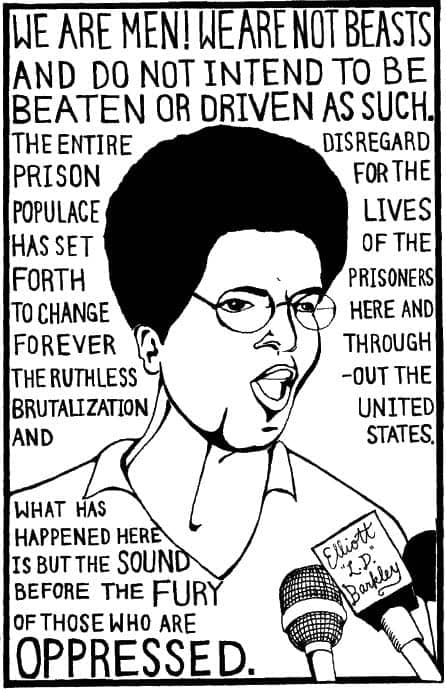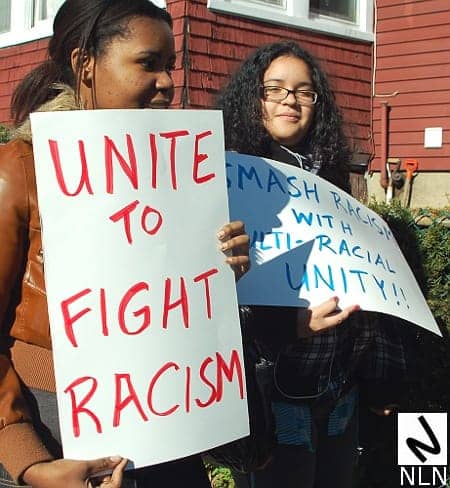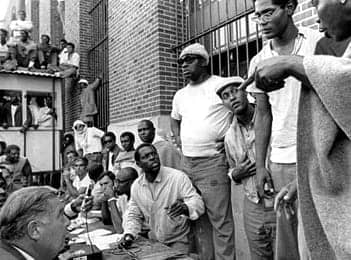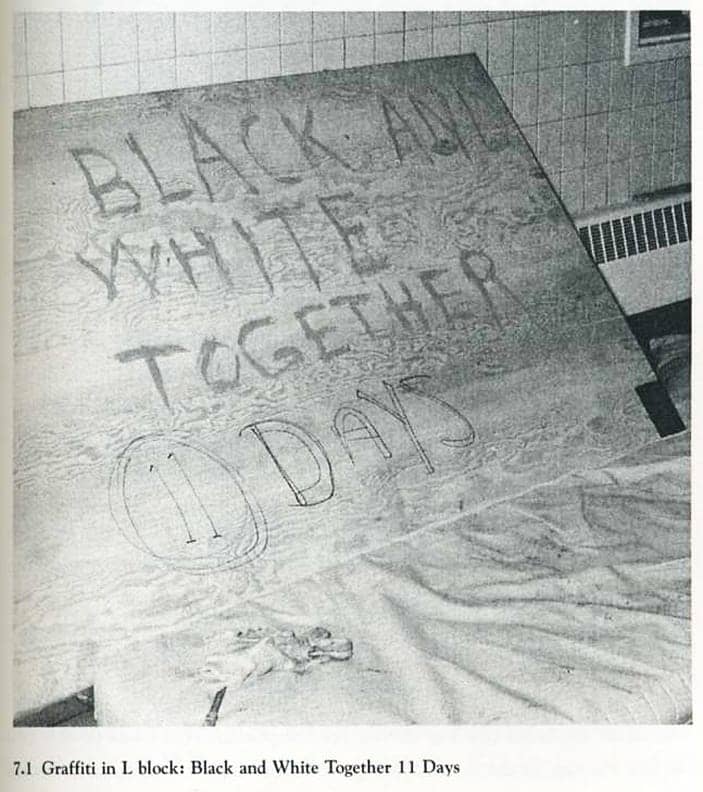Our friend Amédée Garneau sends along this story about tenant organizing in New York.
Direct Action Begins at Home: On organizing with fellow tenants
by Amédée Garneau
The other day I met a student named Yusuf who said he wanted to figure out how to organize with the other tenants in his building. “I was active in community stuff when I was back in L.A.” he said. “But since I moved to New York, I haven’t met any of my neighbours. The one time I did was when my upstairs neighbour had locked himself out of his apartment, and he needed to crawl through my window and onto to fire escape to go in his own window. Other than that, I haven’t met anyone and I don’t know how. I barely see them.”
I understood his frustration – it took me years to meet my own neighbours. People in New York aren’t as unfriendly as our reputation suggests, but we don’t tend to form relationships with the people down the hall, in part because we all work different schedules, and in part because people move around a lot, usually in search of a slightly better combination of rent, closeness to the subway, roommates, and space, and so you’re never sure how long your fellow tenants are going to hang around.
I can also understand why Yusuf wanted to organize. Being a renter in New York is pretty tough – rents are really high, and the living conditions aren’t great. The buildings are old, and much of them were built cheaply in the first place, which makes infrastructure like plumbing and heating unreliable – I have a recurring roof leak, my apartment isn’t hot enough in the winter, and my water takes a long time to run hot. Being a populated city, New York also has a lot of vermin like cockroaches and mice – I have dealt with both. There is also noise and light pollution from nearby bars or construction, which some buildings block out better than others. Landlords tend to move very slowly in resolving any of issues. It took me seven months of calling and emailing my landlord before my last roof leak was fixed – seven months of catching drips with towels, and plaster falling from the ceiling.
Housing, Capitalism and the Law
There is a reason why landlords aren’t very motivated to spend money on repairs. In a capitalist society, the goal of housing is not to give people shelter, but to generate a profit. We’ve seen this with the latest economic crisis: when a homeowner can’t make their mortgage payments, even if those payments no longer have anything to do with the value of the house, they are no longer allowed to live in that house: the bank would rather see it sit empty. The same principle of profit-generation applies to rent. Rent is not determined by what a person can pay, or what kinds of amenities an apartment has, but by what a landlord can command for their own profit. There are a lot of empty buildings in New York just because their owners don’t think the profits would be big enough if they were to get them up and running and fill them with tenants. With the buildings that they do operate, landlords always try to squeeze as much rent as possible out of tenants while providing as little in terms of living conditions as they can get away with. That makes us our interests opposite to the landlords’, and if they have the upper hand, we are vulnerable.
For this reason, some cities like New York have actually written a series of laws to protect tenants. These laws are meant to give tenants some rights to healthy and safe living conditions, to protect them against eviction, and to rein in skyrocketing rents. Without the intervention of these laws in New York, working people would have been completely displaced out of Manhattan a long time ago.
The problem is, those laws don’t always help much, in practice. Most tenants don’t really know their rights, and enforcing them means going through a very slow-moving city bureaucracy, and/or hiring a lawyer. I learned this firsthand when I challenged my landlord for refusing to stabilize the rent on my apartment, even though it legally should have been. I filed a claim, and it took almost a year to get a response from the City, and that was just the beginning of a process that dragged on for several more months. In the meantime, my landlord sic’ed their lawyer on me, and I didn’t have one of my own. Out of fear I settled, dropping my claim about the rent stabilized status of my apartment in exchange for slightly lower rent.
Landlords harass and exploit and bargain with each tenant individually, just like bosses do in the workplace, and they use their superior resources to intimidate us, even finding bogus ways of evicting people if they cause too much trouble (which I was afraid of too). Because of my experiences, and of what I’ve heard from other people, I now believe that tenants, like workers, only have power when united, and that we have to band together to get what we need and want. So Yusuf’s question about organizing is very on point. And I was happy to realize that I had some advice for him.
The Story of My Building
About six months ago, something interesting happened in my building. One of my neighbours, Dean, had managed to collect most of the tenants’ email addresses, just by stopping them in the hallway and asking them. I think his original intention was to invite people to his gigs, since he is a musician. But one day, out of the blue, Dean emailed our landlord’s property manager, Steve, asking very politely if the hallways could be cleaned – they were very dirty, there was mold pushing through the paint, and some minor repairs needed to be done. Dean had emailed the landlord about this many times in the past, but this time he also cc’ed the six other tenants whose email addresses he had collected.
The response from Steve was almost immediate, which was pretty remarkable for a guy who often doesn’t respond at all. Steve told Dean that he would attend to the hallways soon. More interestingly, he asked Dean not to cc the other tenants on correspondence about maintenance issues.
His reaction told us we were on to something. Sure enough, the very next day, for the first time in ten years, the landlord started cleaning the hallways. They sanded down the areas where the mold had grown, scraped the grit off the tile floor, and taped the baseboards and door frames for painting. We were all amazed – ten years of asking for these things, and finally we had some action. It was then that we knew how powerful our simple tactic of speaking to the landlord in unison had been.
A few days later, the hallway work stopped. A week went by. Again, the tenants emailed the landlord, this time with a different neighbour initiating the email chain. And the following day, work started on the hallways again. At this point, people realized this was how to get things done. We started voicing our concerns over this email chain about our own apartments: one tenant’s bathroom tile work was unfinished, and mold was developing; another was suffocating from the dryer exhaust whenever anyone did laundry. The email chain got to be about fifteen emails long with complaints.
Somewhere in this period, I invited everyone on the email list (except Steve, of course) to my apartment for a coffee klatch. A bunch of people rsvp’ed, and a few actually showed. Two of the newer tenants were able to learn from one who had been around for longer about the struggles that had taken place with the landlord in the past. Apparently this wasn’t the first time that the tenants had banded together to get a problem solved. About six years ago, they had formed a coalition to pressure the landlord to reinforce one of the foundation walls, which was showing cracks. One of the tenants knew a good lawyer, and collectively they took the landlord to court. The judge found in the tenants’ favour, but the landlord continued to drag their feet on the repairs. The lawyer then had everyone’s rent reduced to one dollar a month until repairs were done. It seemed like even when using a lawyer to enforce tenants’ rights, it was important to band together, to share the legal resources people were aware of, and to make sure everyone got the same deal.
Once my neighbours and I got in touch, we realized some specific ways we could help each other out directly. One day, my neighbour Jen left a note in my mailbox asking if I could keep an eye on her apartment. She attached an article from the New York Post about a rent-controlled tenant whose landlord had evicted all of her stuff while she was away on vacation. Jen was going away for the weekend, and as a rent-controlled tenant, she wanted to make sure this didn’t happen to her. Of course, I watched her apartment, and kept in touch with her via text while she was away.
The most inspiring moment in our tenant organizing came a few weeks after the hallway work started. The landlord had painted a few swatches of colour in the front entrance hall, apparently testing out different paints to see how they would look. And spontaneously, without any coordination happening over email, the tenants voted on them. There were strips of masking tape beneath each colour swatch, and we wrote our thoughts about the colours directly on them: “Ick!” “Too dark!” “Gross!” “YES!” “This one.” As it happened, the vote was unanimous. And a few weeks later, the landlord painted the hallways with our chosen colour.

This seems like a small thing, but it felt great. We had never had an opportunity to exercise a democratic impulse as tenants. For a long time, we had experienced a landlord who didn’t give a crap about how we felt, never consulting us where the building was concerned, and even ignoring us when we expressed our demands. Now we were talking amongst ourselves, and speaking in unison, and the landlord was actually listening to us.
Extending the Struggle
When Yusuf asked me about tenant organizing, I told him this story. I mentioned the email chain, which seems to work in cases where people have very different schedules. I also talked about posting a “grievances collection” sheet in the lobby, next to the mailboxes, as a neighbour had once done in my building. This is useful for letting tenants know they are not alone in their complaints – maybe everyone has drafty windows, maybe everyone has mice. A grievances sheet can also be used in legal battles with the landlord to show evidence of their negligence. I also mentioned the idea of inviting people to a meeting in his apartment like I had done, sending the invite either via email or a sign posted in the lobby. Yusuf seemed excited about these ideas.
I feel that my experience with my fellow tenants shows once again that the direct action efforts of a small group of united people can accomplish a lot. This time, we didn’t even have to take legal or coercive action to get what we wanted. The very unity of our voice got the goods. And it felt great to use a little bit of democracy to do so.
It was also great to realize that I had advice for Yusuf about tenant organizing. Winning short-term gains from my landlord was satisfying, but helping someone else build their own struggle is even better. If this kind of tenant organizing could spread – to all of the buildings owned by my landlord, further around the neighbourhood, and around the city – we could really get something going.








